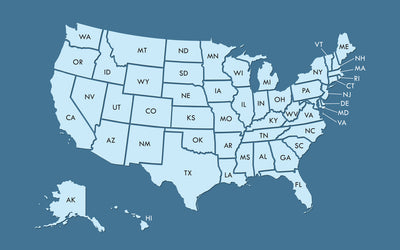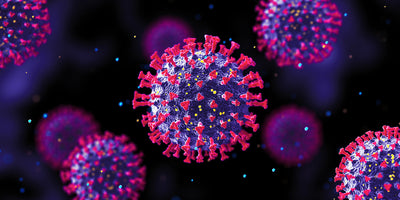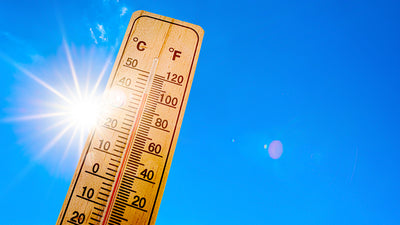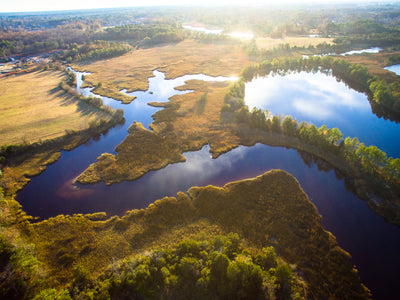States are responding to the nationwide PFAS crisis by implementing testing or removal requirements in municipal tap water. Per and Polyfluoroalkyl Substances (PFAS) have been detected in an increasingly alarming number of municipalities across the United States. Recent studies indicate that 200 million Americans drink tap water contaminated with PFAS chemicals. On April 10, 2024, the US EPA has announced drinking water standards to limit exposure to 5 types of PFAS chemicals.
Water Quality InformationWritten By Actual Experts
RSSDoes My State Regulate PFAS Chemicals in Drinking Water?

EPA Approved Harmful PFAS Chemicals For Fracking 9 Years After Toxicity Was Understood

Analies Dyjak, M.A. | Head of Policy & Perspectives
A report released in July 2021 revealed that the Environmental Protection Agency (EPA) approved the use of PFAS chemicals for fracking, back in 2011. PFAS are a category of cancer-causing chemicals that were used in consumer products like Scotchgard, non-stick pans, water repelling clothing, and commercial products like fire fighting foam and Teflon. Certain PFAS chemicals are no longer being produced, or have been phased out because of their known impacts on human health. However, many other types of PFAS chemicals are still being used, and their widespread environmental damages are just beginning to be understood. These recent findings call into question why EPA approved harmful chemicals for an industry that is already a well known groundwater polluter.
How Does Fracking Pollute Water?
Hydraulic Fracturing or ‘fracking’ is a type of oil shale and natural gas extraction, where a mixture of water, chemicals, and sand are injected into the ground to push out trapped oil and gas. Each free-standing fracking rig can stretch 4 miles horizontally in each direction. Fluid leaks, wastewater mismanagement, and well construction can contaminate surrounding groundwater and soil. The process of hydraulic fracturing also uses a huge amount of water, which is less than ideal during a nationwide drought. Anywhere from 1.5 million to 16 million gallons of water are used to frack one free-standing well.
Fracking Liquids Are Toxic, Carcinogenic, and Protected By Proprietary Claims
There are quite literally thousands of different chemicals that are used during the hydraulic fracturing process, and each has a different job to assist with oil and gas extraction. For example, acids help to dissolve minerals and other impediments to make the oil and gas flow faster through the ground. Corrosion inhibitors make sure that steel isn’t being damaged by other potentially corrosive fracking liquids. EPA identified 1,084 different fracking chemicals between 2005 and 2013 - many of which were protected under proprietary claims.
Why Are PFAS Both Problematic and Effective?
When EPA approved the use of PFAS for fracking in 2011, scientists had already flagged their concerns years prior. EPA scientists responded to a consent order and ultimately advised the agency for more studies before authorizing their use for fracking. According to the New York Times, these studies were never completed and the administration gave companies the green light. So, what makes PFAS different from benzene, methanol and formaldehyde, and other toxic chemicals used by the fracking industry? There are two reasons why PFAS are so problematic: first, they persist in the environment for decades and can travel through water and soil without breaking down. Second, scientists already knew how dangerous these chemicals were before EPA approved their use in fracking. We know this because of the report based on a recent Freedom of Information Act request, and because companies started phasing out PFAS in 2002, 9 years before they were used in fracking.
Fracking companies were desperate to use PFAS because of their effectiveness. PFAS are extremely hydrophobic, and help separate oil and gas from other properties used during the extraction process. This was such an attractive cost-saving measure that it was too good to pass up.
Fracking is One of The Least Regulated Industries in the U.S.
The fracking industry is exempt from all sorts of reporting and disclosure requirements. In 2005, Vice President Dick Cheney called on Congress to ensure that the fracking industry would be safe from potential future regulations. Ironically, Vice President Cheney was the CEO of Halliburton - one of the largest fracking companies in U.S. - directly before taking office. Congress ultimately passed the Energy Policy Act in 2005, which prevented fracking liquids from being regulated under the Safe Drinking Water Act. In the regulatory world, we like to call this the Halliburton Loophole.
Pollution From Fracking is More Widespread Than Previously Thought
Fracking was previously believed to only pollute nearby groundwater, but a recent study found that fracking liquids have made their way into surface waters as well. The study sites inadequately treated wastewater, fluid leaks, and flowbacks as the main sources of surface water contamination. Surface water, like lakes, rivers, and streams, are used by municipalities across the country for drinking water and recreational activities. The correlation between fracking and surface water pollution is concerning with the recent PFAS findings from EPA.
Hydroviv filters are NSF certified to remove PFAS chemicals, and out-competed major brands in a recent Duke University PFAS removal study.
Other Articles We Think You Might Enjoy:Health Effects of PFAS Exposure
Drinking Water Supplies Risk Contamination From Toxic Waste Ponds
Are Endocrine Disruptors in Your Tap Water?
Is PFAS Exposure Toxic To The Immune System?

How Does Climate Change Impact Drinking Water?

Emily Driehaus | Science Communication Intern
Recent IPCC reports provided a look into how climate change has altered global temperatures and weather patterns over the past few decades. The International Panel on Climate Change publishes a "state of climate change" every few years that provides update on how today’s emissions and activities will affect weather patterns in the future, and the effects these changes will have on our lives. The report highlighted how climate change has and will continue to impact the accessibility of clean drinking water.
Why This IPCC Report is Different From Previous Years:
The recent IPCC findings are notable because scientists have determined that it is “unequivocal that human influence has warmed the atmosphere, ocean and land.” The term “unequivocal” is not used lightly in this instance, as scientists do not use absolutes unless the evidence is unquestionable.
Scientists also used paleoclimate data to provide more context for our current period of warming. Our planet goes through glacial and interglacial periods, where a glacial event is followed by a period of time where the climate is warmer. We are currently in an interglacial period after the last glacial period ended about 11,000 years ago. The last interglacial period before our current interglacial occurred about 125,000 years ago. The IPCC report found that “the last decade was more likely than not warmer than any multi-centennial period after the Last Interglacial.” To put this in perspective, Homo sapiens were still mostly living on the African continent 125,000 years ago. The past decade has likely been warmer than any multi-centennial period since Homo sapiens migrated out of Africa and dispersed across the globe.
The IPCC report also included new advances in a branch of climate science known as attribution science. Scientists can now attribute specific weather events to human-induced climate change. In other words, the frequency of extreme weather events, like droughts and hurricanes, is a direct result of human-driven climate change.
The authors of the report included a glimpse of what the future might look like under five different climate scenarios with greenhouse gas emissions ranging from “very low” levels to “very high” levels. Some effects of climate change are now unavoidable and are present in all scenarios, but the intensity of these events is increased as greenhouse gas emissions climb. For example, global surface temperatures will continue to increase in all the presented scenarios, but the degree of warming increases with each climate scenario. Global warming of 2° Celsius is very likely to occur under the “very high” emissions scenario, but is extremely unlikely to be exceeded under the “very low” emissions scenario. These scenarios provide important perspectives on what the future of our planet could look like under different emissions scenarios, as changes in weather patterns will become more extreme with each increment of warming.
What Does All This Have To Do With Drinking Water?
Extreme weather events already have an impact on our drinking water. Droughts reduce the amount of drinking water available due to the lack of precipitation to replace water supplies. Water contamination is also more likely to occur in areas with drought conditions. Hurricanes and tropical storms can also contaminate drinking water supplies with floodwater and leave communities without clean drinking water for long periods of time. Even cold weather events can affect access to clean drinking water, especially in areas that are not equipped with the infrastructure to deal with extremely cold temperatures. For example, the recent round of winter storms that brought freezing temperatures to Texas limited access to drinking water due to frozen pipes, power outages, and boil water advisories.
As global temperatures increase, these extreme weather events will increase not only in frequency but in intensity as well. Drinking water supplies will be threatened by these events more often and the intensity of these events risks damaging water infrastructure that was not built to withstand the extreme weather conditions created by climate change.
The IPCC report also included specifics on how global warming will directly impact the global water cycle. Like weather patterns, the rise of global temperatures will intensify the water cycle, making wet seasons wetter and dry seasons drier. This will have direct implications for areas of the world that depend on seasonal precipitation. Intensified dry seasons will impact agriculture and those who depend on rainy seasons to water their crops. Intensified wet seasons bring the risk of flooding that could potentially damage communities and infrastructure. These intensified seasons will also bring problems with drinking water quality, either due to lack of rainfall to replenish water supplies or too much precipitation that contaminates drinking water supplies with dirty floodwater.
How Can We Stop The Worst From Happening?
It is easy to fall into a downward spiral of negative thinking after reading about how our planet is being irreversibly damaged. However, this report makes it clear that there is still time to change course. While it is too late to stop some warming from occurring, there is still time to cut greenhouse gas emissions and prevent the worst from happening. Now is the time to call on world leaders and governments to implement policies that will lower emissions and protect future generations and ensure a livable planet with access to clean drinking water for all.
Other Articles We Think You Might Enjoy:
How Do Droughts Affect Your Drinking Water?
How Do Hurricanes Affect Your Drinking Water?
Wildfires and Water Quality
Hidden Effects of Drought on Drinking Water







